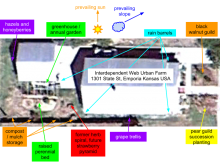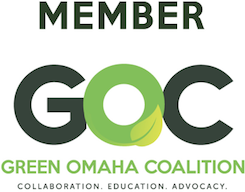Twice the Garden, Half the Work
revised 1/28/2013 for presentation at Butler Community College, El Dorado, KS.
- Read more about Twice the Garden, Half the Work
- Log in to post comments
Illustrated Audio Tour of our urban farm! (2012)
This tour was recorded Sunday, May 6, 2012 (International Permaculture Day). It is illustrated with a series of photos, each marked with the time in the recording when it is described. Click the (i)nfo button to see the timestamps and descriptions; click the right side of each photo to advance to the next.
What's the Ideal Shape for a Strawberry Pyramid?
When I teach intro classes on permaculture design, when we're talking about boundary optimization -- that is, when to maximize the edge and when to minimize it -- one of the questions I like to ask students is along the lines of, "How many strawberry plants, spaced 6" apart, can you fit in 16 square feet and still reach them all easily for harvest?" The exact numbers are not important; what I'm looking for is the ideal design of a strawberry planter to maximize production in a minimum of space.
A modest proposal to fix the Web
As we observe the 25th anniversary of the first World Wide Web site in August 2016, I think it's time to revive this proposal for how to fix the Web. As the de facto repository of all human knowledge it has become, the Web has several significant limitations:
- Read more about A modest proposal to fix the Web
- Log in to post comments
Boundary Optimization and other lessons for Art Therapy
Today we presented a workshop at the American Art Therapy Association's annual conference in Washington, DC. The slideshow for the presentation was too image-heavy to convert to a Google Doc, so we can't embed it here as a slideshow, but you can view or download a PDF copy.
Introduction to Permaculture Design, Bartlesville (2011)
Here are the slides from the two-night introductory class I'm teaching in Bartlesville, Oklahoma, USA tonight and tomorrow:
Engaging our Interdependent Web
Here is the slideshow for the presentation Jessie and I are giving this afternoon at the Prairie Star District Unitarian Universalist Association Annual Meeting in Des Moines, Iowa.
- Read more about Engaging our Interdependent Web
- Log in to post comments
Top 10 Reasons Email Newsletters are a Bad Idea
[note: This article was written in 2011 and is now badly out of date. I'm maintaining it because a number of other sites link to it.]
What does Permaculture Design have to do with Web sites?
I'm in the process of overhauling this site to reflect the fact that I'm shifting the business's focus toward permaculture design. There are a number of reasons why I'm doing this:






